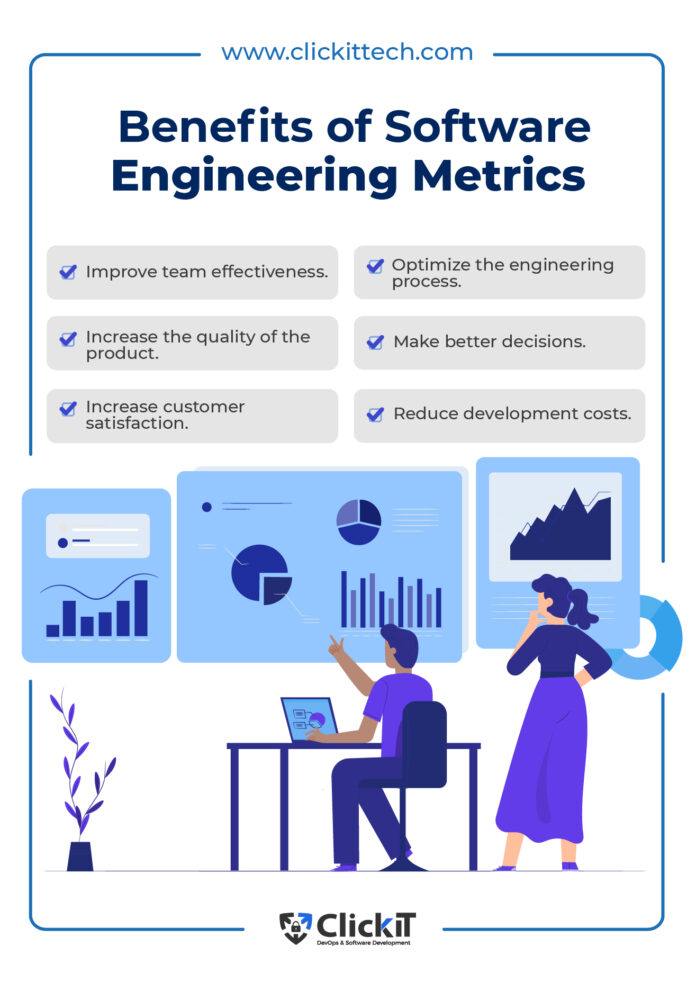Keeping up with the latest developments and operating at top efficiency are musts in the competitive field of engineering. Engineering firms need data-driven insights to make this happen. To make better judgments, streamline operations, and boost productivity, engineering teams rely heavily on technical indicators. In this piece, we’ll discuss the key technical indicators that engineering firms need to monitor in order to succeed in the modern business world.
Excellence in Engineering, Unlocked
Excellence in engineering is not a destination, but rather a way of life. Understanding the key indicators can help you steer your company in the proper direction. These essential technical metrics can help your engineering team succeed.
High-Quality, Maintainable Code
The building blocks of any program start with the code. Significant issues may arise in the future as a result of code that is poorly written or cannot be maintained. Measures of code quality like as complexity, code churn, and comments from code reviews are crucial. This information may be gathered with the use of tools like static code analyzers and code review platforms.
Rate of travel and data transfer
Speed and output are two measures that matter much to agile engineering teams. Throughput is the number of completed tasks or features in a particular timeframe, whereas velocity indicates how much work a team can finish in a certain time frame. The team’s capacity, sprint planning, and bottlenecks may all be estimated with the use of these measurements.
Third, Intervals Between Cycles
The lead time is the total amount of time it takes from when a task or feature request is first started until it is finished, whereas the cycle time is the amount of time it takes to do the task itself. Timely delivery of features and responses to client requests necessitate drastic reductions in lead and cycle times.
Defect Monitoring and Fixing
Bug tracking and management is a crucial aspect of every software project. Insights regarding the software’s overall health and the efficacy of the debugging process may be gleaned from metrics such as bug density, the ratio of open to closed defects, and the average time to resolution.
The Scope and Success Rate of the Tests
In order to guarantee the dependability of software, a thorough testing procedure is required. Indicators of how well your testing efforts are congruent with your quality goals include test coverage (the proportion of code covered by tests) and test success rate (the proportion of tests that succeeded).
Efficiency of the Infrastructure
Server uptime, response times, and resource usage metrics are crucial for engineering teams that operate in the cloud or manage their infrastructure. By using these indicators, we can pinpoint infrastructure bottlenecks and better allocate our limited resources.
DevOps KPIs
Metrics about the deployment process are crucial in today’s DevOps-driven environment. Measures such as deployment frequency, change failure rate, and MTTR are included. With these KPIs, businesses may evaluate how well their DevOps processes are working to guarantee timely and successful rollouts.
The Opinions of Customers and Their Contentment
In the end, happy clients are the key to the prosperity of every engineering firm. You can learn a lot about how well your products and services are satisfying customers by looking at metrics like Net Promoter Score (NPS), customer support ticket volume, and user feedback ratings.
Productivity and Contentment of Workers
Employees who feel appreciated and valued tend to work more. A more productive and creative engineering team may be fostered by keeping tabs on employee satisfaction measures like the employee Net Promoter Score (eNPS).
Tendency Cost Analysis
In the engineering industry, cost management is crucial. Cost control and on-time project completion may be achieved by the use of several metrics such as cost per feature or project, resource allocation, and budget adherence.
Possibilities for Intra-Site Links
Learn more about the methods and advantages of tracking these metrics by reading our in-depth “How it works” articles for each measure. These articles will help you in your quest to improve code quality, streamline your DevOps workflow, and increase staff happiness.
Exploring the Keys to Engineering Success
Let’s go further into some of the major technical metrics listed above to discover the secrets of releasing engineering excellence:
High-Quality, Maintainable Code
The strength of every software system may be traced back to the quality of its code. The quality of your codebase may be gauged by looking at metrics like code complexity, code churn, and comments left on reviewed code. Both high code complexity and high code churn, which measures the rate at which code is modified, can be early warning signs that particular sections of code may benefit from additional review. In order to ensure that only high-quality code is incorporated into the codebase, feedback from code reviews is essential at every stage of development.
2. Rate of travel and data transfer
Agile engineering teams rely heavily on velocity and throughput measurements. Teams may use these indicators to more precisely predict their capacity, allowing for more efficient sprint planning. Teams may boost output by fixing inefficiencies discovered through velocity and throughput monitoring. The key to avoiding burnout is finding a happy medium between working quickly and working slowly.
Intervals Between Cycles
Organizations in the engineering sector who want to speed up the delivery of features and responses to client requests should try to reduce lead time and cycle time. By analyzing these KPIs, development teams may pinpoint bottlenecks in the process and make adjustments to improve efficiency. Quicker feature delivery and reduced lead times imply happier customers and a more formidable market position.
Defect Monitoring and Fixing
Software development inherently involves bugs, but their effects may be mitigated with proper bug monitoring and fixes. Organizations may better control the quality of their software and allocate resources by tracking metrics like bug density (the number of defects per line of code) and average time to resolution. The user experience and pleasure of your customers will increase in direct proportion to how quickly you can detect, isolate, and fix errors.
The Scope and Success Rate of the Tests
The quality and functioning of software relies heavily on testing. Indicative of thoroughly tested code is high test coverage, ideally approaching 100%. If most of your tests are passing, it’s safe to assume that your code is performing as intended. By keeping an eye on these KPIs, you can be certain that your software is both dependable and strong and that your testing efforts are heading in the right direction.
Efficiency of the Infrastructure
Engineering firms that are responsible for infrastructure management or that conduct business in the cloud must have access to reliable infrastructure performance measurements. Infrastructure bottlenecks may be found and avoided with the aid of metrics such as server uptime, response times, and resource consumption. In order to keep the user experience consistent and minimize downtime, a high-performing infrastructure is required.
The software industry has been completely transformed by the adoption of DevOps methods. When evaluating the efficiency of your DevOps pipeline, it is essential to monitor metrics such as the frequency of deployments, the rate at which changes fail, and the mean time to recovery (MTTR). When changes are made often, deployments are stable, and new features are released quickly. Reduced downtime and lessened customer impact are the results of a shorter MTTR following an event.
The Opinions of Customers and Their Contentment
In the end, the success of a company in the engineering field is measured solely by the level of happiness its customers report. Direct insights into how effectively your products and services fulfill consumer demands may be gleaned from metrics such as Net Promoter Score (NPS), customer support ticket volume, and user feedback ratings. Organizations may make better decisions and focus on improvements that matter to their users if they routinely collect and analyze input from those users.
Productivity and Contentment of Worker
Workers who feel appreciated and appreciated are more likely to be creative and productive. Measuring employee engagement with tools like the eNPS may help businesses pinpoint problem areas in the workplace. Making the office a pleasant place to be increases productivity and quality of work life by encouraging teamwork, innovation, and pride in one’s job.
Tendency Cost Analysis
In the engineering industry, cost management is crucial. Costs may be managed with the use of metrics like cost per feature or project, resource allocation, and sticking to a budget. Maintaining financial viability necessitates a thorough understanding of resource allocation and the capacity to keep project costs in check.
Learning more about these technical indicators and improving your company’s method of measuring and enhancing them helps boost creativity, output, and quality in engineering. Staying competitive and providing outstanding products and services in a dynamic market requires decision-making that is data-driven and founded on these indicators.
Conclusion
To succeed in today’s engineering industry, you need more than just technical know-how to compete. It requires a dedication to ongoing development and the use of data to inform decisions. Engineering firms may pinpoint their strengths and improve upon their deficiencies by monitoring and analyzing pertinent technical metrics. So, begin tracking these indicators right away to see your business reach new heights of productivity and effectiveness.







